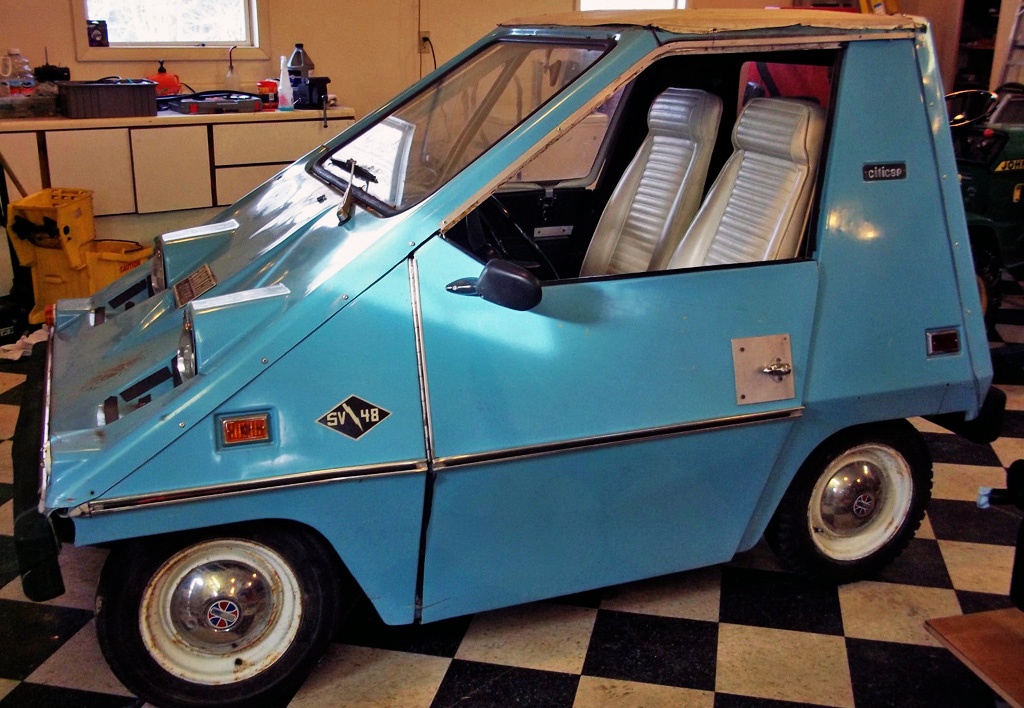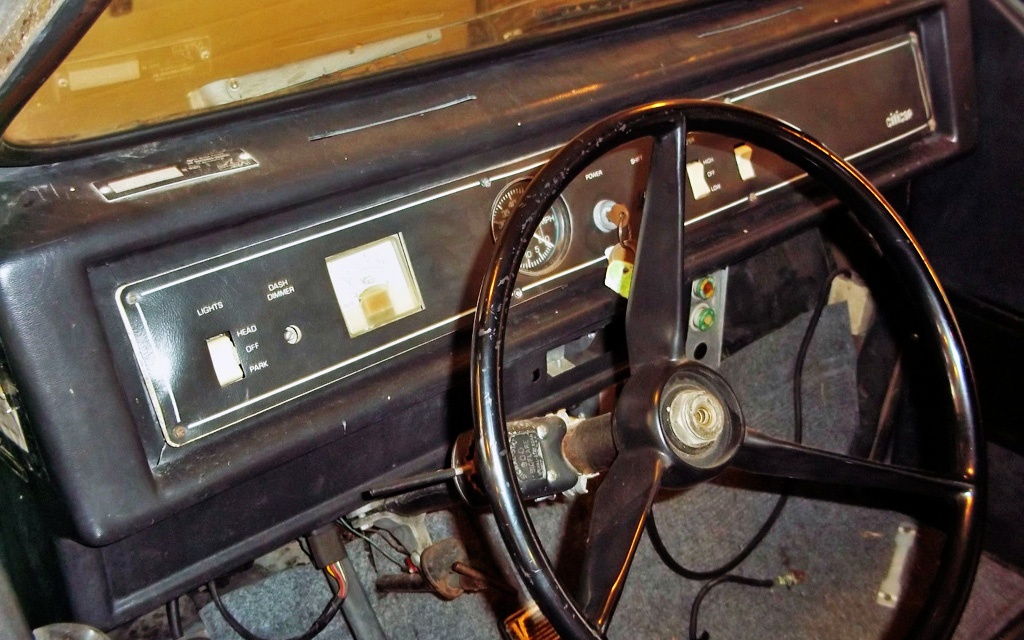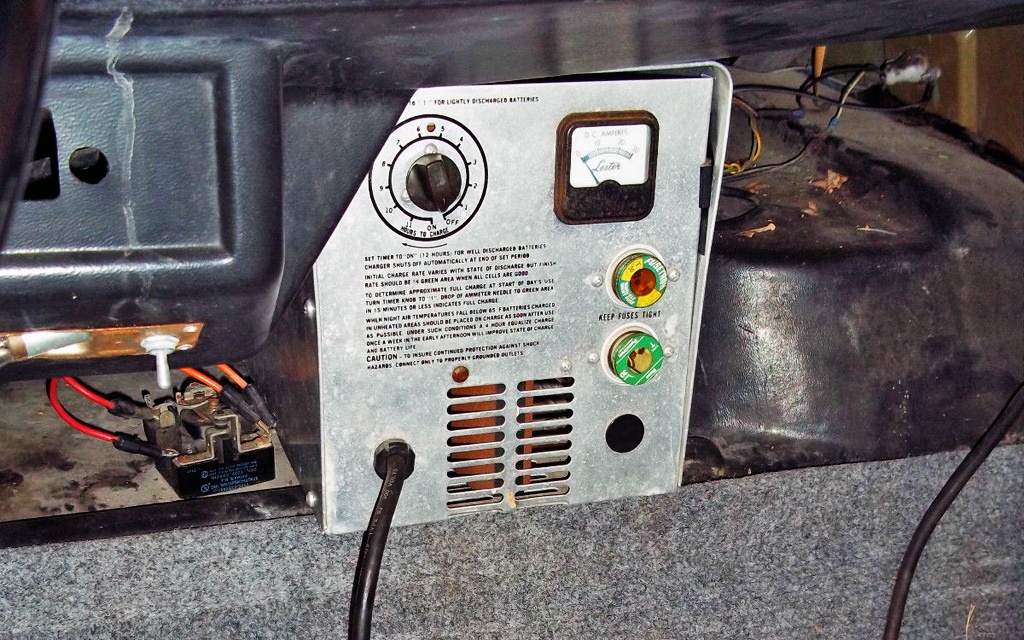When we car nuts talk to those who are less than interested in the history of the automobile, we often get frustrated by those who think electric and hybrid cars are some novel new bit of technology. Yes the technology used in modern electrics is extremely advanced, but it is by no means a new idea. Some of the earliest cars were electric. In fact, back in 1901 Ferdinand Porsche built the first hybrid! Yet the combustion engine has soldiered on as the most economical form of propulsion. We won’t get into a debate of which is better, as both have their strong points. Controversy aside, it’s rather interesting to look at how far electric propulsion has come along and how some things haven’t changed much at all. Take a look at this 1974 Vanguard CitiCar, here on eBay.
This micro faces its own set of issues that aren’t related to being an electric, mostly as a result of being stored outside this past winter. The batteries froze and will need to be replaced, the windshield is cracked, and the body is showing signs of cracking from age. Overall it looks solid and is small enough that restoring the body and interior shouldn’t be much of an issue. Restoring the drivetrain on the other hand is going to require either a working knowledge of ’70s electronics and electric motors or someone who does. After getting it running, don’t plan on getting anywhere too quickly or very far from home. With a full charge and a strong tail wind, this should top out around 30 mph. Range varies based on speed, tire pressure, if the windows are open, your pants size, and just about every other factor you could possible dream up. We have heard reports that some owners have gotten as much as 40 miles of range, but typically get closer to 20. This brings us to one of the most glaring problems with any electric car, range. From day one it was a major issue, but with each generation of technology, range does improve. The batteries that motive these cars are their greatest weakness. Now instead of being powered by the same batteries found in a golf kart, most modern electrics are powered by the same batteries found in laptops and cell phones.
If you have been looking for something quirky to drive or want a cheap car to commute to work in, this CitiCar could prove to be a great option. We aren’t sure how costly it might be to restore all the electrical systems, but we are sure there are other powertrain options out there that would fit. It is truly amazing that Vanguard built as many of these as they did, but the fact that they did proves that people have always been fascinated with the idea of plugging in rather than pumping. It also goes to show us how history has a way of repeating itself. Eventually the current electric trend will fade, just as it did in the ’70s and the ’90s, and we won’t hear much about it for a decade or two and then there will be a resurgence of interest. Let’s just hope the next generation will be more effective and economical for real daily driving. We might be getting closer, but for now we will stick with our internal combustion engines. Would you be brave enough to use it on your daily commute?





I think this uses regular 12V car batteries—8 of them I believe.
Hmmm…maybe $400 for new batteries, plus current to keep them charged, to save maybe $50 in gas for a very small vintage super-economy car to go back and forth to the grocery store?
For me, it doesn’t compute. I’ll take that red 2CV. It holds more grocery bags, too.
But either one would be a terrific conversation starter in the store parking lot.
It always amazed me too how many of these were made and still around (they must have a survial rate higher than vintage Mustangs).
I would tend to disagree with you about how long electrics will stick around this time. I’m pretty sure the percentage of electrics and hybrids is going to increase with time this go around. Gas engines seem to be headed the way of the clutch.
Oh, and before anyone else gets the chance to say it, I will – “Johnny Cab!”
Hi Wiley, you could be right about them sticking around this time. I just don’t see them really being viable enough alternatives at this point to replace combustion. Unless we see a massive jump in technology, I think it will be another 10 or 20 years before they can truly replace gas. We can’t foresee the future though and companies like Tesla are making some impressive advances. We will just have to wait and see!
I’m gonna put on my tin hat with propeller. Yep, internal combustion will eventually be replaced or augmented by electric. Fossil fuels will be replaced by new-gen nuclear generation. Multiple storey car parks will become the new filling stations unless you opt for a pullout cell with can be exchanged within minutes. The momentum behind this? Densely populated cities regulating their traffic and smog with little ‘personal’ cars that drive themselves within the metro confines and supplemented by public mass transit systems.
Tin hat talking? Yes, this is not going to happen for a while. But look at Shanghai and the smog problem. As more of these new population clusters are built, the govts. will step in and restrict freedom of travel where they can because will be at odds with the welfare of the city’s population.
The last places this will take effect? Small and mediums town in the USA. Legacy effect is too strong here, but watch for change in cities like NY and Chigaco. Liberalists will ensure its a slow transition over there, but in more authoritarian countries with no strong legacy of car ownership it will come sooner.
Personally not happy about this, and don’t expect it to affect me in Melbourne for about twenty years. But I can’t help thinking that a car with a 454 is going to be as rare as a guy walking in front of an automobile with a red flag.
I think what is needed to see EV’s become a mainstream consumer product is some sort of technological tipping point. Currently, the best EV is the Tesla Model S and it has a 265 mile range, as certified by the US EPA (I peeked). It is designed with a hot swappable battery pack that can be changed without leaving the vehicle in about the same time it takes to fill up with 15 gallons of gasoline. However, it’s not a particularly inexpensive vehicle and the hot swap battery stations are in a limited number of locations, if they have even been built at all.
In my opinion, the tipping point will come with inexpensive batteries that have a long range and service life. It also will mean adopting a universal standard for EV battery packs so that and EV can be swapped at any charging station, not just ones for a particular manufacturer’s system. The cool thing about such a system is that it can be stocked with a certain number of batteries which can then be charged from a variety of electrical generation technologies, including on site solar.
We do need to reduce our dependency on petroleum if for no other reason than it is a limited resource that will one day run out. Reducing the amount used for transportation increases the amount of time we have to develop alternative technologies for other necessary materials that come from it, like plastics. Figuring out how to insulate wires, make casings for various goods and make medical devices outside the petroleum cycle is crucial if we want our advanced society to continue. Otherwise, the whole thing collapses due to the importance of a single feedstock (which is not renewable). When it goes, so does everything we take for granted.
Since I run a Buick 350, does that buy me extra time over a 454?
Some kind of pro rata deal?
See you at Curbside Classics, Don.
Chris.
Jim-Bob, I think certain cities will reach the necessity before the technological tipping point. Going to be interesting to see what happens.
@Chris. Appreciate the shout out, but please respect your hosts here. If you’re going to mention another site, best make it relevant to the story.
@Don Andreina: Yes they will, but cities are not as big a concern as suburbanites and rural residents since large cities usually have public transportation infrastructure. If you take our passion for the automobile out of the equation it is easy to see that mass transit is the best solution for the kind of close quarters living you have in large cities as it reduces the overall amount of space needed for vehicles. I know that if I was crazy enough to live somewhere like New York, London or Tokyo that I likely would not own a car. It just wouldn’t make sense.
True Jim-Bob. I use public transport when I work in the city and have no problem with it. For people living in a city like NY, not having a car is a choice. But for Londoners, they now have the congestion tax to deal with. So those with money are the one who enjoy the privilege of driving in these areas. Same sort of thing in Japan, with its onerous registration fees for anything over kei. That’s why I’m looking for a baby to restomod. Future-proofing my obsession with cars.
Most people had no idea but the Johnny Cab in the original movie was a highly disguised commuter vehicles Postal Van. Play the explosion scene frame by frame and see the gingerbread come off then the van parts.
There must be a good reason for having one of these minis, but I can’t think of what it would be be. Possibly add a holder for golf clubs? Use it to scare the neighbour’s dog? Last time I looked, the bid was just under $1000, which should win it.
Barry Thomas’ “Wheel to Wheel” blog
The way I see it, why go back to lead-acid batteries? Modern Ni-Cad and Li-Po batteries offer a far better energry storage to weight ratio. Perhaps there is a modern electric car wreck that can donate it’s cells to the refurbishment of a Citicar. The loss of weight would also result in a substantial increase in performance as well as range. The only drawback I can see is cost. Perhaps the best option would be a pack made from multiple Prius battery packs, seeing as they are the most ubiquitous hybrids out there and can likely be found wrecked in large enough numbers. Now if money is not as big an object, a wrecked Mitsubishi i-MEV (full electric car) would be a better donor option as it shares drivetrain packaging with the Smart Fortwo and would be more likely to fit under the rear. The only negative is that Li-Po batteries are VERY sensitive to improper charging and will explode if done improperly, so it is imperative that a proper charge regulation and balancing system be engineered if you go that route.
lectric’ cars have been around for a hundred years…………….they still ain’t cuttiin’ it.
All arguments aside, this car is a dog. A golf cart is more practical because at least it has enough room for a golf bag! So nostalgic though to see the screw-in fuses on the battery charger.
looks like the grandparent of the Smart electric car or not. yes i think they will be worth saving but it would not be a moneymaker anytime soon.
These cars take 8 6volt batteries at a cost of $554, they suck on any hill or grade , top speed 42mph down hill with a tail wind. You really don’t want to drive in any sort of real suburban setting cause you will be run over. No acceleration and terrible brakes when you do get it moving. Also don’t drive without an extention cord on board lest you’ll be walkin home. They are so ugly that they’re almost cute. Want to buy mine???
Here’s a link showing a completly restored Citicar:
http://www.popularrestorations.com/Restorations/Restoration027.htm
Quoting from the link: “This CitiCar is powered by eight six volt, deep-cycle golf cart batteries. It will cruise at 35 miles per hour and go about 20 miles between charges. The eight batteries are arranged in two packs, each supplying 24 volts. When the accelerator pedal is depressed, a series of micro switches are activated. The first runs the packs in parallel for a total of 24 volts but decreases power to the motor with a NiChrome ribbon resistor, taking the car up to 11 mph. The second switch closes a solenoid that bypasses the resistor, taking the car up to 23 mph. The third switch runs the packs in series, for a cruising speed of 35 mph.” Also, “It handles like skateboard! It has instant steering and the brakes are quite comfortable without any power assist. It has little 4.5 inch brake drums which work surprisingly well. The cars came from the factory with disk brakes, but this one came with drum brakes which I believe are better. It was put together well because of the brake and the motor capabilities.”
To heck with it! Buy it cheap and have fun yanking out the electrics and drop in something ozone depleting and hit the road! I bet a 20 hp diesel garden tractor engine would really make this thing move. Even a 3 cylinder Geo Metro engine would have enough power to raise the hair on the back of your neck during hard cornering!